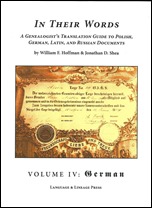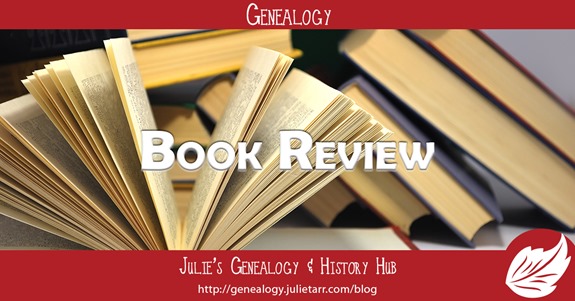 Title: In Their Words: A Genealogist’s Translation Guide to Polish, German, Latin, and Russian Documents, Volume 4: German
Title: In Their Words: A Genealogist’s Translation Guide to Polish, German, Latin, and Russian Documents, Volume 4: German
Author: William F. Hoffman & Jonathan D. Shea
Format: Paperback
Published: 2017
My Rating: ![]()
![]()
![]()
![]()
The following review first appeared in the Federation of Genealogical Societies FORUM magazine (Spring 2019); reprinted with permission.
In Their Words: A Genealogist’s Translation Guide to Polish, German, Latin, and Russian Documents is a series of four books designed to help genealogists and family historians with the daunting task of reading and deciphering documents in these different languages. Volume 4 focuses on German. The authors felt “there was a need for a detailed work written by linguists familiar with the kind of German one finds in such documents, but also with the demands of tracing family history” (ix). I couldn’t agree more!
Chapter 1 kicks off the book with the ins and outs of German grammar. While the authors presented the topic well, it’s still a complicated subject. However, learning German grammar is useful in order to really dig in and understand the various documents one will encounter in their research. This chapter also covers vocabulary such as numbers, days, months, and times. Also discussed is the German alphabet with examples showing letterforms in Fraktur (old German typeface), Kurrent (old German cursive), and Sütterlin (a variant of Kurrent). I found the section on phonetics to be extremely valuable and find myself referring to it often.
While this book is designed to help with the language aspect of German genealogy, the authors included a small chapter on using American records to find a German ancestor’s place of origin. There are several good ideas, as well as hints and tips for success, beyond what one typically finds in instructional German genealogy books. Some underutilized sources include fraternal organization records, enemy alien files, and church histories.
Chapter 3 continues with a look at some of the records mentioned in chapter 2, since American records could be written in German. Records include church records, newspaper items, and even a will. Sample documents are shown as an image, along with a transcription and translation.
Once the American records are found and deciphered, hopefully a place name has emerged. Chapter 4 outlines how to find German places using various tools including gazetteers. In the discussion of gazetteers, sample pages, transcriptions, and translations are provided as a guide. There are also maps of European countries that have or had large German populations including Austria, Czech Republic, Denmark, Hungary, Luxembourg, Poland, and Switzerland. Also included in this chapter is a lengthy discussion of archives in Germany and other countries, covering national, regional, state, and ecclesiastical. To round out the chapter, guidance on writing to various archives is provided.
Chapter 5 presents over 200 pages—a third of the book—of record samples. Each sample is provided as an image, along with a transcription and a translation. Document examples include church records, civil registrations, censuses, military and property records, passenger lists, and many others.
One thing that bothered me was the fact that some of the records were labeled “Poland,” however these records were created when the location was part of the German Empire. This is problematic when searching the table of contents for a specific type of record in a particular time and place. For instance, I wanted to see if there was a sample civil birth record for Prussia in the late 1870s. Glancing at the table of contents, there wasn’t one. I only came across a sample when I read the entire book for this review. It’s labeled “an 1876 Birth Certificate from Wysławice, Wielkopolski, Poland,” but in 1876, it was Wysocki in Kreis Schroda in Posen, Prussia. This was exactly the document I was looking for, but I initially missed it. (I now have color-coded, labeled tabs on the pages that have records relevant to my research.)
Also somewhat problematic in this chapter is that some document captions didn’t match the text in the body of the chapter and/or the table of contents. Additionally, several documents had dates mentioned in the caption and table of contents while others did not. Since this book was designed to be a reference source, these small idiosyncrasies can be challenging when looking for a particular example. I can overlook these given the incredible information provided within this chapter.
Chapter 6 contains over 200 pages of German words. At the beginning of the chapter there are sections for words related to numbers, months, days, family relationships, and causes of death. The remainder of the chapter is a master vocabulary list, arranged alphabetically. While I appreciate the fact that the authors presented the words in Fraktur, Kurrent, and Roman styles, I wish that they were listed by their Roman rendering first, not Fraktur, as it would make it easier to search the list.
Chapter 7 presents German first names with their equivalent in several other languages. Like the vocabulary list, the names are shown in Fraktur, Kurrent, and Roman styles.
Chapter 8 is a short bibliography. Chapter 9 closes the book with an index.
Overall this is a great reference book for those who are working on their German roots. The sample documents alone are extremely beneficial. This book is over 650 pages on 8½″ x 11″ sheets of paper. The larger page size allowed the authors to render the sample document images large enough so the reader can actually read and compare the originals with the transcriptions and translations—a huge bonus compared to instructional German genealogy books that have only a handful of sample documents that are typically too small to read.
Prior to reading the book, I had occasionally poked through it looking for examples. Now having read the book, and knowing what’s inside, I use it daily. I’m strongly considering buying the Latin volume, since I have Catholic Luxembourgers and most of the church records are in Latin. For those who are working on their German roots and looking to decipher documents on their own, this is a must-have book.

